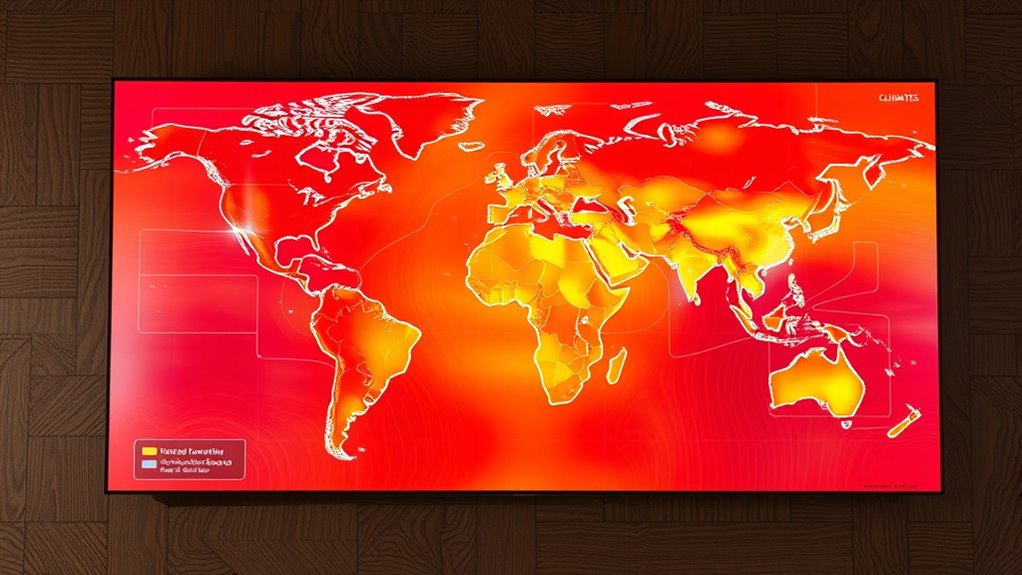Understanding how wood moves across different climates helps you manage its stability effectively. Wood expands with heat and moisture, contracting when cooled or dried, which causes warping, cracking, or gaps. Factors like humidity, temperature, and regional conditions influence these changes. An interactive map shows how regional climates impact wood behavior, so you can make informed choices for construction or maintenance. Keep exploring to discover how to minimize these movements and protect your wood over time.
Key Takeaways
- The map visualizes how temperature and humidity variations affect wood expansion, contraction, and stability across different climates.
- Understanding microscopic molecular changes helps predict long-term wood movement and potential structural issues.
- Coastal regions with high humidity promote wood swelling, while arid areas cause shrinkage and cracking.
- Maintaining consistent indoor humidity and temperature minimizes wood movement and preserves surface integrity.
- Climate-aware planning and construction, guided by the map, enhance wood durability and prevent warping or damage.

Have you ever wondered why wooden floors or furniture sometimes warp or crack? It’s a common question, and the answer lies in the natural properties of wood and how it reacts to environmental changes. Wood is a living material that constantly responds to its surroundings through processes like thermal expansion and moisture absorption. When the temperature rises, wood expands because the heat causes its molecules to move apart, a process known as thermal expansion. Conversely, when temperatures drop, the wood contracts, shrinking back as its molecules come closer together. These microscopic changes, though tiny individually, collectively influence the stability of your wood surfaces over time.
Moisture absorption plays an equally vital role in wood movement. Wood is hygroscopic, meaning it absorbs and releases moisture depending on the humidity levels in its environment. When humidity increases, wood soaks up moisture, causing it to swell. This expansion can lead to warping, cupping, or cracking if the wood isn’t able to release the excess moisture. On the other hand, in dry conditions, wood loses moisture and shrinks, which can result in gaps between planks or structural weaknesses. This constant cycle of moisture absorption and release explains why wood in different climates behaves differently and why maintaining consistent humidity levels is essential for wood’s longevity.
Understanding these processes becomes even more important when you consider an interactive map that shows how wood movement varies across climates. In regions with high humidity, like coastal areas, moisture absorption dominates, leading to swelling and potential deformation if not properly managed. Conversely, in dry, arid climates, thermal contraction and moisture loss can cause wood to shrink and crack. The map illustrates these patterns, helping you see why your wooden furniture might behave differently depending on where you are. It highlights the importance of climate-aware construction and maintenance, emphasizing that controlling indoor humidity and temperature can greatly reduce warping and cracking.
Frequently Asked Questions
How Does Humidity Specifically Affect Different Wood Species?
Humidity directly impacts different wood species by altering their moisture content, causing them to expand or contract. Some species, like oak, are more sensitive to moisture changes, leading to greater movement, while others, like cedar, are more stable. You should consider the specific wood species in your project because their moisture content reacts differently to humidity fluctuations, affecting the wood’s stability and longevity over time.
Can Climate Change Alter Predicted Wood Movement Patterns?
You might wonder if climate change can change how wood moves. With increasing temperature fluctuations and unpredictable weather, wood responds differently, expanding and contracting more often. These shifts can challenge existing wood treatment methods and alter expected movement patterns. As climate change progresses, you’ll need to stay aware of these changes, adapt your wood handling techniques, and consider new strategies to manage wood’s natural responses effectively.
What Are the Best Practices for Mitigating Wood Movement in Construction?
You should focus on best practices for mitigating wood movement by controlling moisture. Proper moisture control prevents excessive wood expansion or contraction, reducing warping and cracking. Use stable wood species, allow for seasonal movement in your design, and install proper ventilation and vapor barriers. Regularly monitor and maintain humidity levels, especially in changing climates, to guarantee your wood remains stable and minimizes unpredictable movement over time.
How Accurate Are Current Models in Predicting Long-Term Wood Behavior?
They say “forewarned is forearmed,” and current models do a fair job predicting long-term wood behavior, but they’re not foolproof. You should know that wood shrinkage and moisture absorption vary with climate, making exact predictions tricky. While models incorporate these factors, real-world conditions can still cause surprises. So, use them as guides, not gospel, and keep monitoring your projects for unexpected changes over time.
Are There Regional Differences in Wood Movement That Impact Global Trade?
You should recognize that regional differences in wood movement substantially impact global trade, especially across diverse climate zones. When trading timber or wood products, you’ll notice that climate variations cause different expansion and contraction patterns. These regional factors can lead to packaging, shipping, and product design challenges. Understanding how climate zones influence wood behavior helps you plan better, minimize defects, and ensure quality in international trade, making your operations more efficient and reliable.
Conclusion
Understanding how wood moves across different climates is vital for your projects. Did you know that wood can expand or contract by up to 1% with just a 30°F temperature change? This interactive map helps you see these shifts in real-time, so you can plan accordingly. By paying attention to climate variations, you guarantee your woodwork stays beautiful and stable over time. Keep these insights in mind to master the science behind your craftsmanship.









